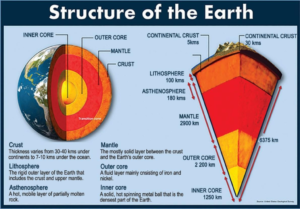Internal Structure of Earth: Crust, Mantle & Core, Discontinuities
The Earth is divided into four major layers: the crust, mantle, outer core, and inner core. Each of these layers has its own unique chemical composition and physical properties, contributing to Earth’s complex structure. The large size, non-uniformity, high density, and varying temperatures within these layers make understanding Earth’s interior essential for geologists and scientists.

1. Crust
The crust is Earth’s outermost layer, characterized by its solid and brittle nature. There are two types of crust:
- Oceanic crust: It is thinner, averaging about 5 km in thickness.
- Continental crust: This crust is thicker, averaging 30 km but can reach up to 70 km in areas with major mountain ranges, such as the Himalayas.
The density of the crust also varies: the outer crust has an average density of 2.7, while the lower crust has a density of around 3.0. The continental crust is thicker than the oceanic crust, particularly in mountainous regions.

2. Mantle
Beneath the crust lies the mantle, which extends from the Moho’s discontinuity to a depth of about 2,900 km. The mantle is composed of silicate minerals rich in iron and magnesium.
- The upper part of the mantle is called the asthenosphere. It is partially molten and extends up to 400 km in depth, with molten magma in motion.
- Above the asthenosphere is the lithosphere, which includes the crust and the uppermost solid part of the mantle. The lithosphere’s thickness ranges from 10 km to 200 km.
The mantle is now divided into three zones based on seismic studies:
- Zone 1: Extends from the Moho’s discontinuity to 200 km.
- Zone 2: Extends from 200 km to 700 km.
- Zone 3: Extends from 700 km to 2,900 km.
Seismic wave velocity slows down in the upper mantle, particularly between 100 km and 200 km, forming the zone of low velocity. The lower mantle is solid and extends beyond the asthenosphere.
3. Core
The core is the innermost part of Earth, divided into the outer core and inner core. The core-mantle boundary lies at a depth of 2,900 km.
- The outer core is in a liquid state, with the boundary between the outer and inner core located at 5,150 km.
- The inner core is solid and composed primarily of nickel and iron, often referred to as the nife layer.
The core plays a crucial role in generating Earth’s magnetic field and holds key information about Earth’s early formation and evolution. The core’s thermal and compositional characteristics also influence the mantle, crust, and atmosphere.
4. Discontinuities in Earth’s Layers
Earth’s internal structure is marked by several discontinuities, which are transition zones between layers. These discontinuities are characterized by changes in density, seismic wave velocity, temperature, and pressure.
The five main discontinuities are:
- Conrad Discontinuity: Between the SIAL (continental crust) and SIMA (oceanic crust).
- Mohorovičić Discontinuity (Moho): Marks the boundary between the crust and the mantle.
- Repetti Discontinuity: Separates the outer mantle from the inner mantle.
- Gutenberg Discontinuity: Transition zone between the mantle and the core.
- Lehmann Discontinuity: Separates the outer core and the inner core.

Each of these discontinuities provides insights into the complex structure of Earth’s interior and is essential for understanding the dynamics of tectonic plates and geological processes.
Download Our App Now!

